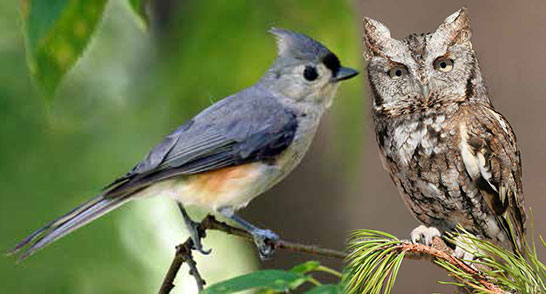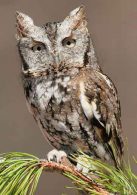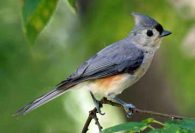Nature Notes
Excerpted from “Rocks, Plants, Birds and People of Fishers Island” [1999]
by the late Edwin Horning
Birds No Longer Nesting or Decreasing
Barn Owl: This owl once nested in the old ice house on the shore of Middle Farm Pond. The last time that it nested there was in May 1955. Later, sometime in the 1960s, it nested in the Firestone boathouse. It now (1999) nests in rock piles on Block Island.
Broadwinged Hawk: This small buteo nested once in 1955.
Chipping Sparrow: This sparrow nested regularly in the 1960s. I once found several nests in a thicket along the shore in the Hungry Point Island area.
Common Tern: This tern once nested in Wicopessett and Wreck Islands on the rocky shore between Beach Pond and Block Island Sound. It last nested on Stony Beach, at the very tip. There were about 20 nests with 2-3 eggs in each nest. They now nest on Great Gull Island, which is a sanctuary.
Grasshopper Sparrow: This sparrow of the grassland nested during the years 1953-1967. Lee Ferguson discovered it on May 17, 1953. They nested in the grass on the former Parade Ground at Fort Wright where 12 pairs nested in 1961. They also nested at Middle Farms.
Harrier: Once called the Marsh Hawk, this bird once nested frequently. Will Sinclair, once manager of the Ferry District, remembered as a boy seeing their nests in the grassy field behind his home, which was across the road from the water works. The house in which he lived is now called Road View and the grassy field is now a woodland. The harrier last nested in 1978 near an elderberry clump near Beach Pond. There were five young hatched and fledged.
Horned Lark: This bird, now sometimes seen in winter on bare or almost bare ground at the airport has nested at least once. A nest was found in the parking area at the Airport in July 1976.
Hummingbird: Nests have been found rarely on the Island, in 1961 and in the 1980s, and most likely still nest. The nests are tiny, well hidden, and hard to find.
King Rail: On a summer day in 1969 while on a nature walk to Middle Farms and while driving along the dirt road along Middle Farm Pond, a lady exclaimed, “What is that little black bird crossing the road?” I thought starling, but stopped the car and we were surprised to see a small fluff of black making its way across the road and behind it a large brownish bird, unmistakably a king rail. Both disappeared in the high grass along the pond. During the Bird Atlas taken during the years 1980-1985, none were seen in all of New York State. But on a foggy day in the late 1980s, I made my way through wet grass to the Movie Pond and there was surprised by a mother and two babies, still fluffy black.
Least Flycatcher: A pair nested in the Brick Yard in 1923.
Meadowlark: This bird of the grassland was once a common resident. Now it is seen in only the spring and in the fall as it migrates through the Island.
Nighthawk: In the early 1960s Lee Ferguson wrote, “There are not nearly as many nesting places as when the Island was all in pasture and the ever-increasing vegetation must account for the growing scarcity of nighthawks, but they are still common enough.” As of 1999, I seldom see them.
Piping Plover: This pale shorebird regularly nested on the airport beach and near Beach Pond in the 1960s and 1970s. During the early 1980s the population plummeted and once one young was seen in 1980. They are now seldom seen. Most frequently a prospecting male is seen and then only in migration during late April or May. It is now endangered.
Screech Owl: I have neither seen nor heard this bird on the Island. But H.L. Ferguson wrote, “A few breed. Two collected 11-14-1914, 12-17-1921. One killed in tree with axe 12-18- 1925.” And Lee Ferguson wrote, “In the 1930s these owls were common in the maple woods on Fishers Island when
they were year-round residents and nested in flicker holes. Only recent record: 12-20-1957.”
Sedge Wren: This is a small wren of the wet grassland. I discovered it nesting in the wet grasslands. In just such a place I discovered it nesting in 1975 during late July. It also nested in 1976 and 1977. I have not seen one since.
Nesting Birds that are Increasing
Barred Owl: This owl was considered to be very rare by Henry L. Ferguson. It is now quite common and even nests in a specially built owl nesting box at Greg and Anne-Marie Thibodeau’s.
Cardinal: The first cardinal was seen October 10, 1945 and nested in 1955. Now very common. Cedar Waxwing: Once rare, now common and seen even in winter.
Double-crested Cormorant: This cormorant was discovered by Noble Proctor on an April day in 1975. Noble landed in a helicopter on the Country Club Golf Course, made his way to the Hungry Point islands, waded out, and discovered about 15 nesting cormorants. There are now more than 300 pairs nesting there and they are seen everywhere.
Gadwall: This middle American duck was seen early in 1954 but was so rare that when seen again by Lee Ferguson in 1960 on Barley Field Pond considered so rare that he showed the duck to me. Since that time it has nested for several years. Glossy Ibis: First seen in 1952, it is now quite common, arriving in April, visiting the ponds, and nesting on South Dumpling Island.
Great Black-backed Gull: This gull was seen early in this century only in winter and only in small numbers. It began to nest on Long Island in 1942 and on Fishers Island in the sixties. It now nests on South Dumpling Island and on Flat Hummock.
Great Crested Flycatcher: H.L. Ferguson never set eyes on this flycatcher. If you visit the Brick Yard Woods in May you will hear its loud call, louder than any other bird. It once nested in the bird box near the Museum.
Great Egret: It first nested in 1952 and now nests on South Dumpling Island.
Hairy Woodpecker: It is still an uncommon nester.
House Finch: In January of 1968, Yola Scagliotti called me on the phone and said that a banded bird was feeding at her window feeder. I saw the bird up close but could not find it in the Peterson Guide—for a good reason as it was not yet in it. They are now numerous but were recently victims of an eye disease.
Least Tern: It was uncommon in 1962, but now nests although still endangered.
Little Blue Heron: This is another species that has made its way up from the South and now nests in very small numbers on South Dumpling Island. It has nested on the Island.
Mockingbird: In the early 1960s this bird was so rare that Lee Ferguson pointed it out to me perched atop the army barracks where the school now stands. Lee and Charlie listened to the songs of the bird and wrote the sequence down. For two years in a row, 1997 and 1998, the mockingbird has nested in a stack of lobster pots at Paul Tombari’s place.
Mourning Dove: It began to nest in 1958. In the spring of 1999, Ricky Ahman, while working with his metal detector, found a nest with two eggs in the thicket near Mary Walter’s garden.
Osprey: The first record of a nest was in 1946. In 1961, there were six nests and in 1999, seven. As of June 12 a young head was seen in two of the nests, at the transfer station and at the
nest at the east end of Middle Farms.
Oystercatcher: The first one was seen in 1960, the first nest in 1976. There are now about eight pairs nesting on the Island.
Snowy Egret: Once rare. Now nests on South Dumpling.
Mute Swan: This common swan, now seen in every pond, first nested in 1957.
Red-tailed Hawk: Now much more common—probably three or four pairs.
Tufted Titmouse: In the late 1970s Serge Doyen called me and said that he has a rare bird at his feeder. Indeed he did—a tufted titmouse. It now nests but only a very few.
Whip-poor-will: Henry Ferguson first heard this bird’s call. It has since nested several times. Theresa Horn once showed me a nest and on the following year another.
Wood Duck: The fledged young of this duck were seen in the woods near the water works in 1993. Several nest boxes have been put out by Dick Baker and Ken Edwards.




